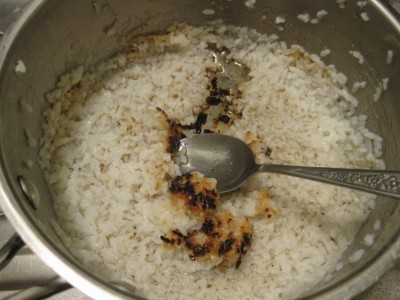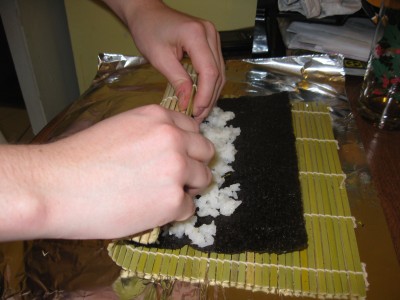Sushi At Home
/https://tf-cmsv2-smithsonianmag-media.s3.amazonaws.com/filer/20110520090112IMG_0870-400x300.jpg)
On New Year's Eve, my boyfriend and I decided to try our hands at sushi. We eat sushi out pretty frequently, but something about making it in my own kitchen seemed terrifying. It was easier than I had expected, albeit time consuming. Definitely something I recommend trying for a sushi eater. If nothing else, it'll give you more respect for the sushi chefs at your regular haunts.
Sushi actually refers to the rice, not the raw fish, and I had read that cooking the rice properly is the hardest part. We bought sushi rice, a short-grained white rice, from a regular grocery store. Step one, according to the package, was to wash the rice until the water ran clear. Some manufacturers coat rice with a talc powder for packaging and washing removes this. Step two was to soak the rice in the cooking liquid for 30 minutes. This allows moisture to permeate the entire rice kernel so that the rice cooks more evenly. After soaking, we were to bring the water and rice to a boil, then turn down the heat, cover and simmer for 30 minutes. The stove in my house is on the older side, and it has all but lost its finesse. It can boil a pot of water but it lost the ability to simmer ages ago. When turned down lower than medium, the flame will extinguish within a few minutes.

I tried my best to maintain a simmer, but when I took off the top after the 30-minute simmer and 10-minute rest, I found a lot of fluffy white rice and a layer of burnt rice at the bottom. We were able to salvage most of it, so the sushi experiment continued. We added sushi vinegar, a mixture of rice wine vinegar, sugar and salt. The rice turned out well considering the earlier mishap, though it was a bit gummy, probably from overcooking.
As for the fish, we opted to buy sushi-grade fish from BlackSalt in D.C. We had eaten there before and gawked at all the fish in the fish market on the way to our table. We bought half a pound of salmon, a quarter-pound of yellowtail and a quarter-pound of tuna. (My apologies to Amanda, but the issue of sustainability only crossed my mind after we had made the order.) We learned a valuable lesson this time around: Buy less fish than you think you'll need. We ended up with way too much sushi and enough leftover fish for a salad the next day.
The other integral sushi elements—soy sauce, wasabi and nori (dried seaweed)—we bought at the regular grocery. We were excited to find a wasabi imported from Japan only to find on closer inspection that it was horseradish. Imitation wasabi is very common because the real thing is so expensive and perishes quickly—the reason why chefs put the wasabi between the fish and rice. I mistakenly assumed that imitation wasabi was less potent than the real thing and globbed it heavily on our nigiri. I was wrong. Apparently it's just the opposite.

We made a few nigiri—just rice and fish—so we could taste each fish, and then a few rolls: spicy salmon, salmon with avocado and lemon, yellowtail with asparagus and tuna with cucumber. Although I had expected the first roll to end up as a misshapen mess, the result looked like a smaller version of what you would get at a real sushi restaurant. We learned here, too, that less is better. Because sushi gets rolled up, it isn't necessary to cover every last bit of nori with rice. In fact, if you do that, your rolls will have too much rice and not enough filling. We also learned that wetting your hands with ice cold water helps when handling the super sticky rice. We tried the same trick with the knife when cutting the rolls, and it worked. It wasn't as hard as I had though, but it certainly took more time. We started at about 7:30 PM and finished just in time to clean up and watch the New Year's countdown.